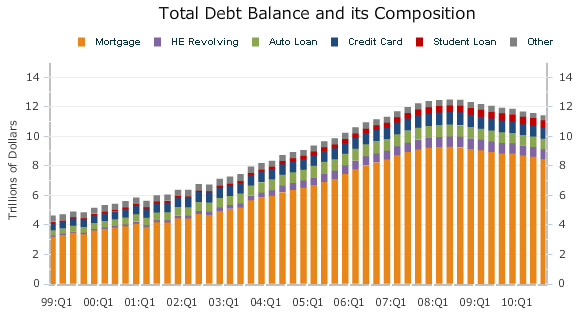By: Andrew_Butter
Along with the emergence of the much heralded “Green Shoots” that must by now be turning into roses (?), has come the sinking realization that (a) just piling debt on debt is not a long-term solution to anything, and that (b) perhaps there might have been more “wrong” under the blanket of mark to market (when markets were in a bubble), and mark to fantasy when they crashed, than can be swept under the carpet forever; like perhaps something structural?
Q4-2008 was the first time in the history of America that over 40% of “recorded” imports of “goods” (“recorded” as in excluding recreational drugs), came from just (a) imports of “Petroleum and related products” (oil), plus (b) imports from China.

The wiggly black line at the bottom of that chart is the combination of Section M412 “Home entertainment equipment” (mainly televisions), plus section M400 “Apparel, footwear & (soft) household goods” (mainly clothes), plus section M411 “Recreational equipment & materials ” which includes as a sub-section M4112 “Toys, shooting & sporting goods, and bicycles”.
Added together those illustrate the main driver of the seasonality of US imports from China, as in “Christmas”.
Sub-section M4112 is interesting. Evidently in USA “shooting goods” (guns) are considered to be a “recreational” product like toys; naturally no mention is made of “recreational drugs” which could easily be $35 billion a quarter, although no one knows because either (a) that’s a matter of National Security or (b) no one wants to know.
If you think all of that sounds mildly insane, wait until I tell you how America finances its addiction to (a) Oil, (b) Chinese Christmas Presents, (c) “Recreational” Guns, and (d) Imported Recreational Drugs.
The blue line on that chart is Line 55 from the BEA publication “U.S. International Transactions Accounts Data”; “technically” that’s called “Foreign-owned assets in the United States, excluding financial derivatives (increase/financial inflow ()” . In Plain-English that’s how much further America got into debt to foreigners, every quarter.
The Big Picture is (a) that all of the foreign debt America piled on since 2000 and before, was to pay for its trade deficit (well everyone knows that but no one wants to talk about that either), and (b) a large part of that came from sales of “Toxic Assets” (the green line).
Q2-2007 was a record quarter; back then America managed to persuade foreigners to hand over $700 billion to help finance their “China Syndrome”, which makes TARP look like chicken-feed (remember that was in one quarter). They did of course promise to pay the money back, (with interest); or more to the point, they promised that their grandchildren would pay it back, which is the sort of promise that crack-heads make all the time.
That was also the peak in sales of “U.S. securities other than U.S. Treasury securities” , you can find those on Line 66 which covers what some people call “Troubled Assets”; as in “Toxic”.
Note: Any connection with “Route 66” which is where Bob Dylan once said, “You can get your kicks”, is completely co-incidental. There again, selling some “Toxic” is a good way to finance the process of “getting your kicks”.
Notice how the red squiggly line (the trade deficit) is pretty much mirrored by the blue squiggly line (how much new debt gets piled on).
In technical terms, over that period 87% of the changes in “piling on the debt” can be explained by changes in the trade deficit in that quarter (i.e. plot one against another and you get an 87% R-Squared).
The difference (i.e. the 13% residual) is explained by (a) investments by Americans outside USA (for example in Special Economic Zones in China) and (b) imports of recreational drugs, which as explained above, are not recorded (obviously).
The problem of course with regression analysis is that it does not prove cause. No one knows whether the process is that (a) Americans borrow money from foreigners so they can blow it on wasting imported energy and buying guns for recreation, or (b) they blow the money first and then borrow later.
It is also possible that the two processes are completely independent, although with an 87% R-squared, that sound quite unlikely.
Cause and Effect
This chart is a little complicated to figure out, the lines are (a) the imports of oil (in dollars) compared with (b) Line 55 (basically new foreign debt), expressed as a percentage of the average from Q-1 2000 up to Q4 2003.
The idea is that perhaps that represented a “normal”; then there was something “abnormal” which happened starting in 2004; so the chart is a way of looking at that:
Two things jump out of that chart, the first is that perhaps the spike in oil prices was somehow “caused” by the preceding spike in USA borrowing from foreigners?
That makes sense intuitively, although of course that’s not proof. But if that’s what happened it would be a nice example of how bubbles are sort of “infectious”.
How about this for a story-line:
A: The housing bubble encouraged people to use their homes as an ATM.
B: Then they felt “rich”, so they went out and bought a lot of toys; and guns, and SUV’s to burn up imported oil (with gun-racks); and perhaps even recreational drugs, it was “party-time” after all.
C: So imports went up.
D: But money “needed” to be borrowed to buy the foreign exchange and to keep the “mighty dollar”, well…mighty.
E: So Goldman Sachs and the other “God’s Workers” packaged up all the loans that American home-owners had taken out using their houses as collateral and sold the loans to Norwegian pension funds, RBS, and other not-very-smart foreigners.
F: Then the housing bubble collapsed, and so it got harder and harder to find any not-very-smart foreigners who were inclined to lend any more money.
G: So anyway, the “God’s Workers” were hanging around wondering what to do for an encore, and there was still plenty of money sloshing around looking for a home, so they got in the act and placed big bets on oil prices going up, so oil prices went up.
H: Then because no one could persuade the not-very-smart foreigners to buy any more “Toxic”, imports went right down because there was no money to pay for them.
J: Then luckily the Fed intervened, and everything is just wonderful again! The best of all beautiful worlds, America can still borrow money from foreigners to pay for its trade deficit.
I can’t prove that’s what happened, but it’s a nice story; but perhaps I missed something, like perhaps there is a cunning PLAN?
Bubbleomics
What’s interesting now; is what’s going to happen next?
Notice the symmetry of the blue line around the average from 2000 to 2003 (i.e. 100% by definition on the chart). That’s typical “bubbleomics”, like every action, has a reaction.
Think of a market like a flat pond, then someone throws a stone in, or there is a wind; then there are waves.
The amplitude of the crest of the waves compared to the “natural” level of the pond is exactly equal to the amplitude of the trough that follows the crest, and the distance in time or in space between one trough and the next, is exactly equal to the distance between one crest and the next.
Bubbles are typically caused by market distortions, typically thanks to manipulation of the market by one group of people for their own personal gain, typically the manipulators are either the government, or the banks; and the reason for that is because to play that “Great Game” and win you have to have access to cheap money.
If that “debt splurge” was a bubble it lasted from Q2-2004 and crossed the “fundamental” on the way down in Q2-2008 (four years), so things ought to get back to normal on that front in Q2-2012, but it’s got there one year too early.
Debt, like drugs, is all about the dosage:
I had a friend when I was growing up called David; I ended up as a boring-old-fart, that’s what my daughter says anyway. He grew up to be a part-time saturation diver and a part-time heroin addict; both of which activities, are much more exciting than anything I ever did. The money he made living for months at a time in a steel tube sitting on the deck of an offshore oil rig, paid for the heroin and for his Ferrari.
I never noticed that he suffered any particular harm from the heroin. He was super-fit; you need to be fit to be a diver and he could run for hours, and he was a really nice guy, whether he was stoned or straight.
One day he explained to me that the most important thing about being a heroin addict is to get the dose right; that’s if that’s what you want to do with your life. Too little and well it’s a bit of a waste, too much and well you are dead; and in fact that’s sadly what happened to him.
The point of that story is that although debt is useful, particularly if you used it wisely like to do a money-making project now that you wouldn’t otherwise be able to, too much can make you do stupid things. Just like heroin is useful, it’s still by far the cleanest painkiller with the least side-effects ever found. But all drugs can be dangerous, particularly when you start using them for recreation.
This analysis suggests that America can safely borrow (net) about $200 billion a quarter from foreigners to finance (mainly) it’s trade deficit (that’s a trillion a year), and not suffer any big consequences; and that number will go up in line with nominal GDP. That’s the maximum “safe” dose.
2008/09 was a scare and the addict had to be revived by artificial resuscitation. But now it looks like the addict is heading back to its old ways, look at the first chart; imports from China in Q3 2010 were more than ever before in the history of America.
Tell-tale signs of suicide attempts
This article is not about “What’s Good for America”, it’s about how to make not to end up in the same neighbourhood the next time America has a suicide attempt.
In that regard it’s worth watching “Line 55”, and the trade deficit.
The two “headline” pieces of data are Chinese imports and oil prices; unless America starts to get serious about making an environment that is as friendly to enterprise as Special economic Zones in China, and about its dependency on oil, at least until it can figure out a way to pay for oil and toys without borrowing money from foreigners to pay for it, that is always a danger. And price of oil isn’t going down.
Continue reading this article >>





















